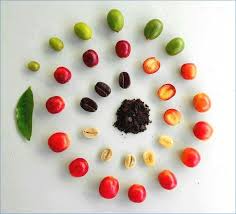
Arabica and Robusta

There are thousands of different varieties of coffee beans, but they primarily come from two main species: Arabica and Robusta. Arabica beans are known for their smooth, mild flavor and are generally considered higher quality, while Robusta beans have a stronger, more bitter taste and contain more caffeine. Within these species, there are numerous cultivars and variations, each with its own unique flavor profile influenced by factors like growing region, altitude, soil conditions, and processing methods.
Robusta coffee plants are hardier and more disease-resistant compared to Arabica plants, which makes them better suited for cultivation in lower altitudes and warmer climates. They also contain higher levels of caffeine than Arabica beans.
In the late 19th and early 20th centuries, Robusta coffee cultivation expanded beyond Africa to other tropical regions, including Southeast Asia. Today, countries like Vietnam, Brazil, Indonesia, and India are significant producers of Robusta coffee. Vietnam, in particular, has become one of the largest producers of Robusta beans globally.
There are over 100 species of coffee, but the two main species that are commercially cultivated for consumption are Coffea arabica and Coffea canephora, commonly known as Arabica and Robusta, respectively. These two species dominate the global coffee market, with Arabica being the most widely consumed and prized for its superior flavor profile.
Within each species, there are numerous varieties or cultivars, each with its own unique characteristics in terms of flavor, aroma, and growing requirements. Some of the popular Arabica varieties include Typica, Bourbon, Gesha (or Geisha), and SL28, while Robusta varieties include Robusta 1 and Robusta 2.
Additionally, different regions and microclimates produce coffee beans with distinct flavor profiles due to factors such as altitude, soil composition, and weather patterns. For example, coffee from Ethiopia may have floral and fruity notes, while coffee from Colombia is known for its balanced acidity and rich body.
Overall, the diversity of coffee beans is vast, offering a wide range of flavors and characteristics for coffee enthusiasts to explore and enjoy.





